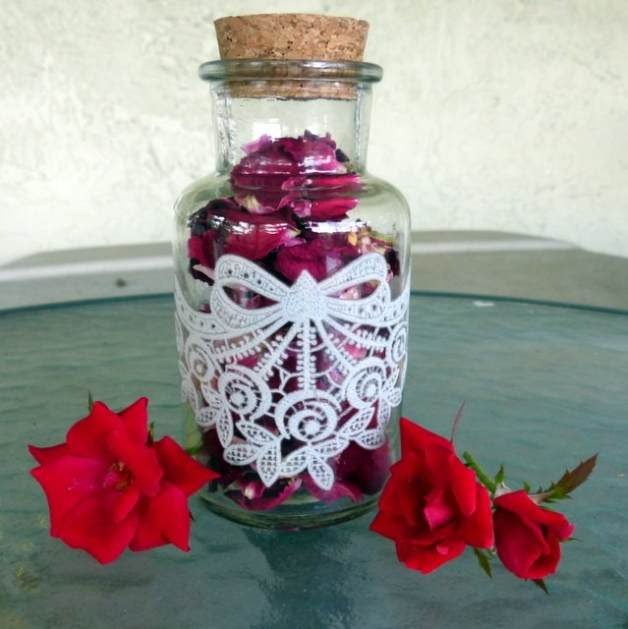Anyone who’s ever stood in the garden tools aisle of a home improvement store knows the feeling: so many choices. Which ones do you really need? How do you choose the right style or size? How much is too much to pay? Maybe you should just give up, go home, and watch some more HGTV, right? Relax, we’ve got you covered with an essential garden tools list. When it comes down to it, most gardeners really only have a few tools they use on a regular basis. They’re the garden tools that live at the front of the shed, where they see an almost daily workout. These are the 10 tools we’ve rounded up here, the ones every gardener should keep on hand and well-maintained. We’ve also got tips for making the right selections for each of these garden tools, and keeping them in good shape year after year.
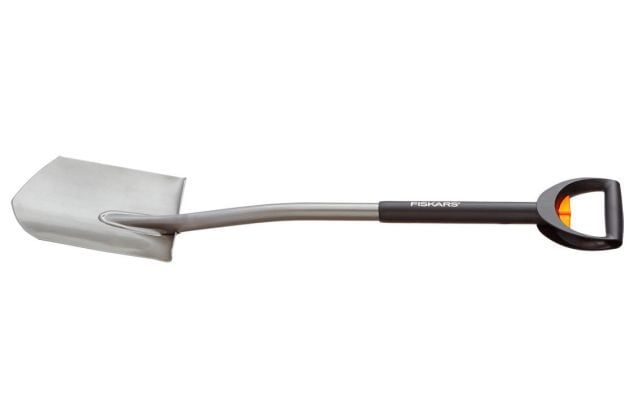
Shovel
Call it a shovel or a spade – it’s the No. 1 need on every garden tool list. “Spade” is generally used to refer to a flat-edged tool used mainly for cutting and digging. “Shovels” are a little more versatile, with a rounded edge that’s often still plenty sharp for cutting through sod, but also able to scoop and move soil and mulch.
Look For: Choose a shovel with a handle length that’s convenient for your height. The top edge of the shovel should have a flat ledge, so you can comfortably step on it with your foot for more digging power. Look for thick-gauge stainless steel blades that won’t bend or rust.
Check out the best gardening gear for kids.
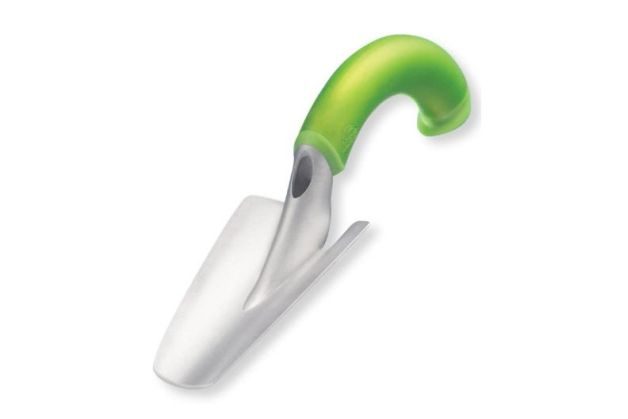
Trowel
Shovels do the heavy lifting, but hand trowels pull their weight too. They’re ideal when you’re planting smaller annuals or loosening up the soil around the base of existing plants.
Look For: Two factors matter most here: the strength of the trowel itself, and the comfort of the handle. Trowels are often called on to do some chopping through tough roots or compacted soil, so pick one made of sturdy material that won’t bend under pressure. Since this tool gets a lot of use, look for one that’s easy on the hand with a padded grip. Newer ergonomic handles are better on the wrists, too.
Psst—we found the best gardening gift ideas for any occasion.

Rake
Rakes have two general uses in the garden: raking up leaves and other debris (leaf rake), and loosening and smoothing soil (bow rake). Depending on your yard, you may need one of each type on your garden tools list. Psst—fall leaves make great mulch for your lawn.
Look For: Leaf rakes (shown above) should have strong flexible tines. In the past, they were often made of aluminum, but plastic can work well too. Bow rakes are sturdier, with tines to break up soil, while the back side of the head is used for leveling. For both, avoid materials that may rust over time, and regularly check to see if tool heads are coming loose from the handles.
These are the best garden hoses of 2022.
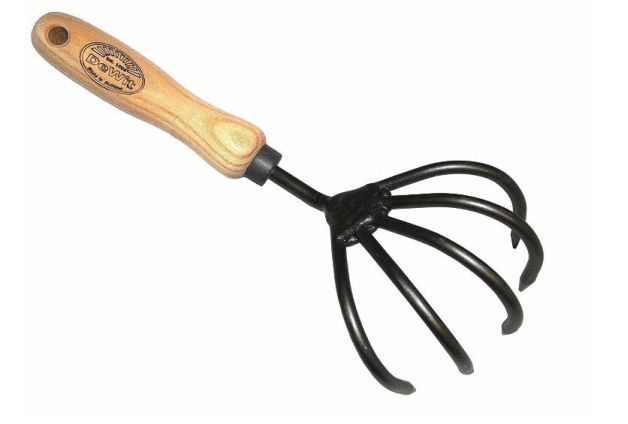
Cultivator
Think of a cultivator sort of like a bow rake for your hand. This is the sort of tool you’ll use to loosen soil along with a trowel when planting annuals, or for doing small cleanup in hard-to-reach places.
Look For: Choose a cultivator with strong curved tines and a comfortable handle. Narrower cultivators are good for very tight spaces between plants, while wider ones are ideal for breaking up soil before planting. Here’s the best slip-on garden shoes for spring from Zappos.
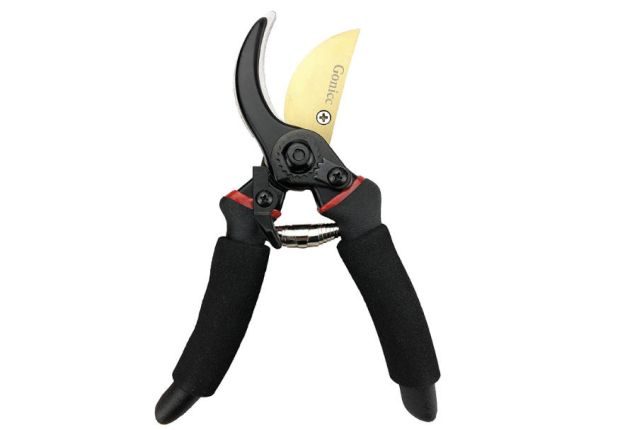
Hand Pruners
Hand pruners come in two styles, bypass and anvil. In anvil pruners, the two blades meet in the middle. Bypass pruners have a top curved blade that actually passes next to the lower blade, making a cleaner and more complete cut. Gardeners tend to prefer bypass pruners for this reason.
Look For: You’ll reach for bypass pruners over and over again in the garden, especially for woody stems. Choose those that open and close smoothly, with padded or rounded handles for comfort. Good pruners should lock shut when not in use. Keep them completely free of rust, and have them sharpened every year or so as needed.
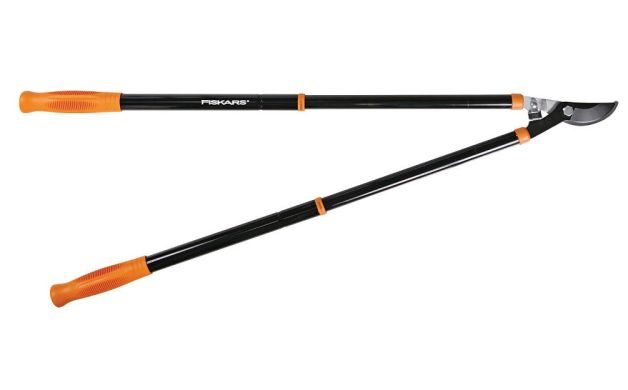
Loppers
Loppers are basically bypass pruners with long handles. Their long handles enable you to reach high areas, and the leverage they provide allows you to cut through thick branches in a single squeeze.
Look For: Extendable handle loppers expand your reach even further. Nonstick coating on the blades help them slide through even tough wood with ease. As with other cutting implements, keep them clean and dry when not in use.
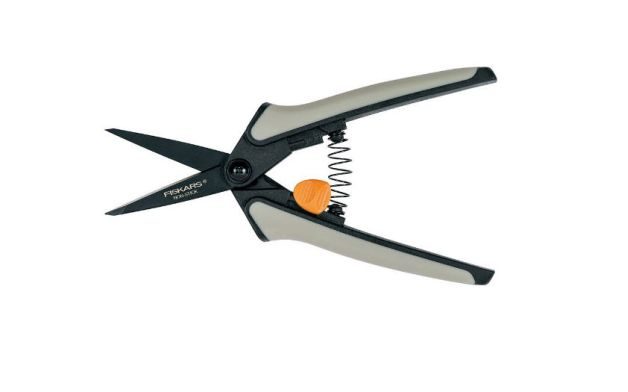
Snips
While pruners and loppers are for tough cutting jobs, snips are there to handle the details. Dead-heading, cutting flowers, snipping herbs for the kitchen…these tiny blades are better than regular scissors because they offer more control.
Look For: The best snips have fine blades that allow you to make delicate cuts, but are strong enough to snip through sturdy stems. Snips with a small cover for the tips let you slide these little must-haves into your pocket so they’re always handy.
Learn how to arrange fresh cut flowers like a pro.

Watering Can
In a day when nearly everyone has a garden hose or two handy, do you really still need a watering can on your garden tools list? We say yes. Sometimes lugging a heavy house around is just inconvenient. Watering cans are especially nice when planting new annuals or seedlings, and are essential when using water-saving rain barrels.
Look For: Buy a watering can large enough to make your trips worthwhile, but not one that will be too heavy when it’s full. Galvanized metal may last longer, but plastic cans are durable as long as you protect them from extreme temperatures. Removable sprinkler heads are a nice feature too.
Check out tips for watering container gardens.

Weeder
Unfortunately, there’s no magic garden tool on this list that pulls weeds for you. But there are some that make the chore a whole lot easier. Good weeders slice through roots and aerate soil with less fatigue on your hand and wrist.
Look For: The classic Cape Cod weeder is the gold standard in this category. The blade chops through the toughest stems and roots, loosening the soil and making the weeds easy to pull out. Due to the strain, these weeders sometimes come loose at the handle, so buy a brand with a lifetime warranty to save money on repairs down the line. Here’s more ways to win the war on weeds.
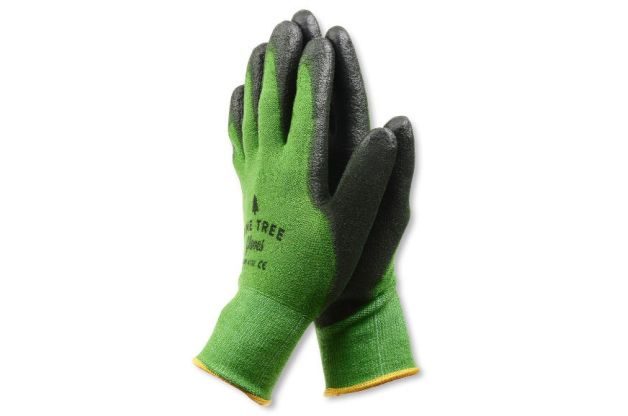
Garden Gloves
There are those who prefer to garden without gloves, and we get it—we really do. There’s something about the feel of soil between your fingers that’s so satisfying. But we also know that same soil is often full of bugs that bite and sharp stones, so the protection of garden gloves is simply a must for many. We think they are important to include on your garden tools list.
Look For: Buy gloves that fit, first and foremost. Too much extra material flopping at the ends of your fingers makes it hard to feel what you’re doing. They should also fit snugly to the wrist, to keep soil and bugs out. Latex-coated fingers are water-resistant, and leather will help protect you from thorns and sharp sticks. Some styles are machine-washable, but you can still expect to have to replace your gloves every year or so in many cases.
Next, check out the best sun hats and visors for gardening from Zappos.

Nothing is as satisfying and easy as a flowering shrub that attracts early spring pollinators—and a sand cherry shrub is the perfect plant for the job.
Gorgeous white or pink flowers are beacons to birds, butterflies, bees and more. Plus, sand cherry is low-maintenance and it has traits that will make any gardener happy outside of spring too.
Check out the top 10 small shrubs for small spaces.
How to Grow a Sand Cherry Shrub
Here’s what you need to know about sand cherry before planting.
- Botanical name: Prunus pumila
- Zones: 3 to 7
- Light needs: Full sun
- Soil: Well-draining
This shrub is very easy to maintain once it’s established. It just needs the right conditions. Consider growing it as a drought-tolerant ground cover shrub or low hedge. Either option will add structure to your landscape.
It tolerates full sun and occasionally dry soil. So if you skip a watering, you won’t be left with a wilted plant.
As a bonus, this plant is also a native that plays an important role in supporting beneficial insects.
See more easy-to-grow native plants.
Year-Round Backyard Benefits
Spring isn’t the only time that this plant is a standout. In summer, tiny cherries appear on the upward arching branches. The stems are also dotted with glossy green willow-shaped leaves.
In fall, sand cherry shrubs make another beautiful, fiery transition. The leaves take on a red-orange color. (Psst—we found the best fall shrubs to grow).
Once the leaves drop, the swooping branches form a very unique shape that looks great in winter.
Discover 6 perennial plants with year-round bird benefits.
Plant Sand Cherry for Wildlife
The nectar-rich blossoms in spring offer pollen and nectar for a variety of beneficial backyard visitors. The flowers feature five tiny petals and pretty yellow stamens.
Backyard birds that eat berries such as cedar waxwings and American robins love the small dark cherries in summer. When winter arrives the dense stems provide shelter for birds, too.
Where to Buy Sand Cherry Shrubs

Jade Parade is a standout cultivar with a spring display that lasts for weeks and bluish-green leaves.

Pawnee Buttes works well in xeriscape gardens as well. It’s tough as nails and tolerates sandy soil.
As winter comes to a close, some of the first signs of spring are experienced during the month of March. For gardeners, daffodils poking up through the soil are an eagerly anticipated sign of warmer weather and colorful blooms to come. Cheerful and bright, daffodils are also the March birth flower.
Here’s everything you need to know about the March birth flower and what it symbolizes. And if your loved ones have March birthdays, we found the best March floral-inspired gifts to help them celebrate. Don’t miss these pretty rose gift ideas.
Not celebrating a March birthday? Don’t worry—we’ve got you covered with birth flower gift guides for January, February, April, May, June, July, August, September, October, November and December too.
What Is the March Birth Flower?
Daffodils are the birth flowers for March. This perennial yellow spring flower is also commonly known as narcissus, it’s botanical name, and jonquils, a specific type of narcissus (Narcissus jonquilla). Most commonly found in gorgeous hues of buttery yellow, you may be surprised how many colors, shapes and sizes daffodils come in. They’re perfect for adding vibrant color and a sweet scent to gardens, but can easily be grown in indoors if you don’t have the outdoor space. The beauties are simple to grow and don’t require much attention.
Here are best daffodil bulbs to plant.
What Are the Meanings of March’s Birth Flower?
Because daffodils are usually one of the first flowers to bloom after winter, they symbolize rebirth and new beginnings. The cheerful color also symbolizes happiness and joy. For such reason, the daffodils are also a common gift on 10 year wedding anniversaries.
The daffodil has taken on significance around the world. Because they bloom around Chinese New Year, daffodils are known to bring good luck and prosperity in China. In England, daffodils are referred to as “Lent lilies” because they bloom between Ash Wednesday and Easter.
Check out some more of our favorite yellow flowers for your garden. And if you have a February, April or May birthday, this is the February birth flower, this is April’s, and this is May’s.
March Birth Flower Gift Guide
Now that you know more about March’s birth flowers, we’ve got the perfect gifts for everyone on your March birthday list—from garden flags and daffodil bulbs to scented candles and personalized necklaces.
Daffodil-Scented Candle

This hand-poured candle features the distinct scent of daffodils. The packaging celebrates March birthdays with a description of what the daffodil symbolizes on the gift box and the outline of a daffodil printed on the glass candle container. The giftee can re-use the jar after the wax melts, too.
Personalized Acrylic Flower Print

Daffodils bloom all year long on this personalized acrylic art piece. The March birth month flower is printed directly on a clear piece of acrylic and displayed on a small wood stand. Add two lines of personalized text, such as a name and birthday. This would look beautiful on a bookshelf.
Daffodil Garden Flag

Welcome guests to your house or patio with this cheerful garden flag, made of fade-resistant polyester. A crate of bright yellow daffodils makes everyone smile and feel at home. Don’t miss these gifts for sunflower lovers.
Daffodil Bouquet

Can’t deliver a gift in person? Send a bouquet of fresh-cut daffodils to someone celebrating a March birthday. The cheerful yellow and bi-color blooms are sure to bring joy to their special day. Add mylar balloons and chocolates to really make an impact. Here are more ways to send flowers.
Daffodil Wall Print

Enjoy a pop of yellow with this beautiful illustration of a vintage seed packet of daffodils on a cream or dark sage-colored background. This artwork also includes the meaning of daffodils: hope, rebirth and renewal. Note that the print in shipped in a hard-backed envelope but does not arrive framed.
Pop-Up 3D Daffodil Card

Send a big beautiful bouquet of paper daffodils to your special someone with this pop-up 3D card. This gorgeous card is a piece of art that can be enjoyed all year long—without being watered! You can also add a hand-written message for a personalized touch!
Daffodil Bulbs

The gardener in your life will appreciate this mix of trumpet daffodil bulbs in a variety of colors and shapes. The best part? Your gift keeps on giving when these bulbs re-bloom in the years ahead.
Daffodil Necklace

This gold-plated necklace features the March birth flower, daffodils, and small rhinestones. This gift comes with a second necklace to create a beautiful layered look. These come in every birthday month flower option, making multiple birthday purchases easy.
Daffodil T-Shirt

This retro-chic cotton t-shirt is printed with a beautiful vintage botanical print of a daffodil on the front. Available in a cream or white shirt, this unisex-sized shirt is a wonderful gift for anyone with a March birthday.
Personalized Daffodil Bouquet Mug

Make their favorite hot or iced drink all the more special with a glass or ceramic mug personalized with their name next to a pretty daffodil illustration and their birth month. They’ll love it all year-round.
Birth Month Flower Glass

Make a toast to March birthdays with this memorable birth month flower glass. To make them, beautiful daffodil blooms were carefully pressed and turned into digital prints to adorn the sides of curved glass tumblers.
Shopping for a bird lover? How about a hummingbird gift?

If you’re looking to bring sparrows into your backyard, you’ll be pleased to note it’s not too complicated to attract them. There’s no need to wonder, “What do sparrows eat?” In fact, chances are good you already have everything you need.
These cheery brown fliers are pretty low-maintenance birds, and they aren’t particularly fussy eaters. (Just ask the invasive house sparrow, which you’ll find snacking on a variety of human and bird foods, everywhere from backyard feeders to outdoor restaurants and amusement parks.)
Find out what foods juncos eat and how to attract them.
Seed and Feeders for Sparrows

To attract more desirable native sparrows, you need only offer sunflower seed, safflower seed, white proso millet, thistle seeds or cracked corn. Whichever seed you choose, make sure it’s on the ground, where sparrows prefer to dine.
As general ground-feeding advice, only serve a little bit of seed each day. The birds will still find it, but you’ll have fewer unwanted overnight guests (like raccoons). Plus, you won’t have to worry about the seed getting soggy when it rains. When sprinkling seed on the ground for your feathered friends, it’s best to place the food near cover, such as a brush pile or small shrubs.
Learn about the types of sparrows you might see, including the white-crowned sparrow, white-throated sparrow, chipping sparrow and Lincoln’s sparrow.
Occasionally, you might be able to attract sparrows to feeders. Large bird feeders with a good amount of surface area, like tray or platform feeders, are good at replicating open spaces. You might also try filling a bird bath with seed, although that might also attract other critters like squirrels.
Wren vs sparrow: what small brown bird are you seeing?
Plants for Sparrows

Sparrows eat plant material as well. Ornamental grasses and sunflowers are excellent choices for gardeners hoping to feed them. These plants offer plenty of seed for the birds to eat.
And if you have an abundant garden filled with native plants, trees and shrubs, you might draw sparrows during nesting season (psst—here’s how to keep house sparrows out of bluebird boxes). Then, the adults will snack on a variety of insects including caterpillars, wasps and beetles, and feed them to their young.
Next, check out 20 pictures that will change how you look at sparrows.
On This Page
Mourning Cloak Butterfly Markings

The appearance of a mourning cloak butterfly typically signals the start for spring for many people. Look for dark maroon wings, yellow speckling on the leading edge and a yellow band on the outer portion of the wing. Also look for blue dots that run along the yellow band. Their wingspan is 2 1/4 to 4 inches.
“I captured this shot of a mourning cloak (above) getting nectar from a coneflower in my garden. I have a fairly large yard with lots of flowers and trees. The mourning cloaks seem to like an area with dead leaves, tree stumps and branch piles,” says Brenda Doherty of Ariss, Ontario.
See 6 common swallowtail butterflies you should know. Plus, here’s how to identify a red-spotted purple butterfly.
Where to Find a Mourning Cloak Butterfly

You can find this big, distinctive butterfly throughout North America—and almost throughout the year. Mourning cloaks can spotted anywhere from northern Canada all the way to Guatemala. They’re also seen in Europe and Asia. A huge plus for butterfly lovers is that mourning cloaks frequent a variety of locations, including banks of streams, woods, parks and suburbs.
While most butterflies pass the winter in the caterpillar, pupa or egg stage, the mourning cloak hibernates as an adult. This means it could come out on warm winter days. Even in the north, it will fly during February thaws, and it makes a stunning sight as it glides through snowy woods.
See where another springtime visitor, white peacock butterflies, can be found.
What Do Mourning Cloak Butterflies Eat?
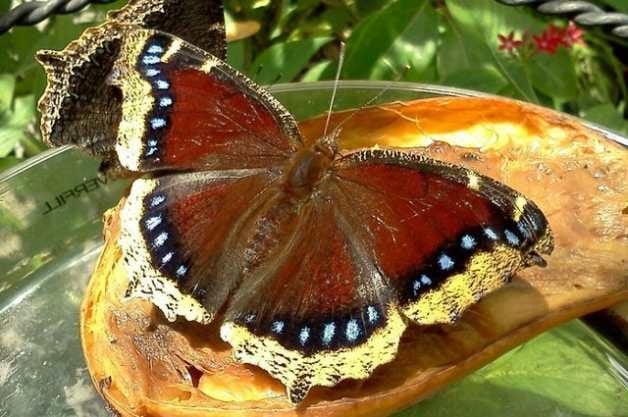
Unlike some other butterflies, mourning cloaks tend to prefer tree sap and decaying fruit more than flower nectar. Try setting out overripe bananas or other pieces of fruits to attract them–but don’t forget to bring the plate in at night at prevent unwanted pests.
Look for clouded sulphur butterflies in your backyard.
What Does a Mourning Cloak Caterpillar Look Like?

This striking caterpillar’s black body sports large red patches along the top and tiny white dots all over, with dramatic spikes, called scoli, on its back and sides.
Want to attract more pollinators? Plant a caterpillar cafe in your butterfly garden.
Mourning Cloak Butterfly Eggs and Host Plants
Look for the uniquely shaped eggs, which are either light yellow or pale green before eventually growing darker, on the leaves of their host plants: willows, poplars, elms and other trees.
See what a sphinx moth caterpillar and pupa looks like.
Some women get flowers, I get bags of insects and dead and diseased plants. But I love it. During my travels to garden shows around the country, I connect with thousands of gardeners, field their burning backyard questions and offer diagnoses. Here are six of the most common plant problems that gardeners ask about.
1. How Often Should I Water Indoor Plants?

The answer to this plant problem probably isn’t the answer you want to hear: It depends. The amount of water a plant needs is based on type, light exposure, potting mix, temperature and humidity. If your house is warm and you’re growing a tropical plant in a sunny window, you need to water more often than someone who keeps a cool house and has less light. When in doubt, test the moisture level by sticking your finger into the top inch or two of potting mix. Cacti and succulents like to go a bit drier, while tropical plants prefer consistently moist, not wet, soil. Pour off excess water that collects in the saucer beneath the planter to prevent root rot.
Check out tips for reviving potted plants.
2. What’s Wrong With My Plant?
I see this question every time I open my email inbox. First, identify the plant and get to know its ideal growing conditions and common ailments. Make sure you’ve got the preferred soil and are providing the right amounts of water and sun. Next, do an internet search for insect and disease plant problems. Local university and botanical garden websites are your best online resources. If the problem is cosmetic and won’t compromise the plant’s health, you may want to live with it, since the plant can. But if the plant’s health is in danger and you want to save it, use the most eco-friendly option available.
Here’s how to tell if your plants need more sun.
3. What Is This Mystery Plant?
Make plant ID easier for yourself, or whomever you enlist to help, with basic information about the subject, such as age, size, growth habit and bloom time. If possible, take close-up pictures of the leaves, stems and flowers and then the whole plant. Or take a physical sample to your local garden center or extension office. Make sure the leaves, and, if present, flowers are attached. All these clues lead to a quicker and more accurate plant identification.
Discover the best natural way to kill weeds.
4. Where Did the Holes in my Hosta Leaves Come From?

Slugs are the main culprits, but earwigs, hail, frost and even falling maple seeds pierce leaves. Slugs and earwigs prefer the cool, dark locations that hostas thrive in. There’s an easy remedy, though. Sink a shallow can filled with beer near the hostas, or set a half-empty beer bottle on its side in the hosta area of the garden. Attracted to the fermenting yeast, the slugs crawl into the container and die. You can set a trap for earwigs. Place a piece of crumpled paper under an overturned flowerpot overnight. In the morning, lift the pot and shake the paper over a can of soapy water. This is a natural way to check for, and control, backyard earwig populations.
Discover 8 bugs you should never kill in your garden.
5. Is it a Weed or a Flower?
First, keep in mind that a weed is just a plant out of place. Even good plants are deemed weeds if they’re unwanted in your garden. If a mystery plant fits any or all of these descriptions, you may have a weed on your hands:
- It’s multiplied considerably since last year.
- It’s sprouted up throughout the bed and surrounding lawn.
- It has been in the garden for a few years, never seems to bloom and has unimpressive foliage. (But remember: Perennials and biennials do not bloom in the first summer, and some plants need a few years to establish and flower.)
- You don’t like it. Once you decide a plant must go, keep the aggressive and invasive ones out of your compost pile or they will return. Dispose of them as recommended by your municipality. If it’s just a matter of taste, find a gardener willing to take an ugly duckling off your hands.
Discover 30 common lawn weeds and how to ID them.
6. Why is There White Powder on My Plant’s Leaves?

It’s a fungal disease called powdery mildew. Over time, it blocks sunlight, causing foliage to turn yellow and, in severe cases, drop off. Fortunately, this disease doesn’t usually kill healthy plants, though it does affect appearance and reduce vegetable productivity. If this disease annually causes plant problems in your garden, it may be time to take action. Plant something a bit shorter in front of the susceptible specimen. The shorter plant masks the unsightly mildewed leaves but allows you to enjoy the blossoms. If you want to take a more aggressive course of action, organic products are available. Do a thorough cleanup and discard infected leaves in fall to reduce the source of disease next year. Stop powdery mildew before it starts by choosing mildew-resistant varieties whenever possible. Give plants plenty of room and sunlight; sufficient light and airflow reduce the risk of the disease.
Next, learn how to prevent brown spots on plant leaves. And check out these 6 genius garden hacks to save you time and money.
Spring is a busy time in the vegetable garden. Before you get growing, you need to know how to thin seedings.
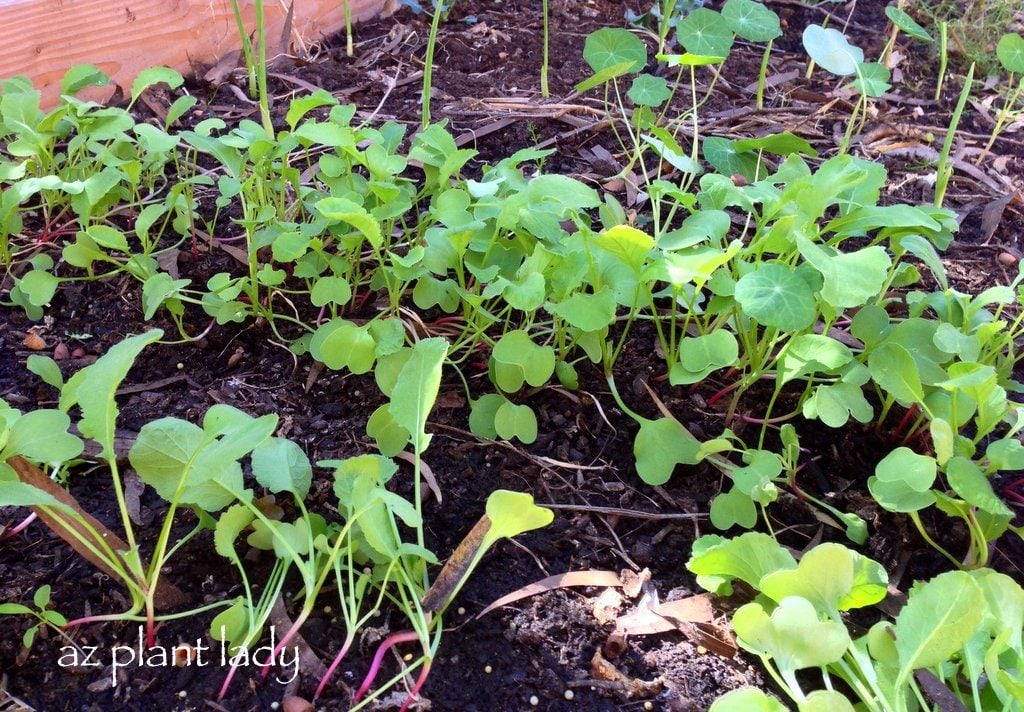
If you have already planted seeds, vegetable garden may be already full of small seedlings that are beginning to sprout and grow. You may notice that your seedlings may look a bit crowded like my young radish plants, above.
When you plant vegetables from seed, you often have to plant more seeds than you will actually grow to maturity because not all seeds will germinate. However, after the seeds begin to grow, you need to ‘thin’ them out.
Psst—here’s how and when to start seeds indoors.
How to Thin Seedlings
So what does thinning seedlings mean? Thinning is the practice of removing excess seedlings.
Why should you ‘thin’ your extra seedlings? Isn’t it better to let them grow so you will get more vegetables? No. The main reasons for thinning out excess vegetable seedlings are so that your vegetables have room to grow to their full size and they won’t need to compete for limited nutrients and water.
- You should pull out excess seedlings once they have grown two ‘true’ leaves. These aren’t the first leaves that appear—those are called ‘seed’ leaves. True leaves are shaped differently than the seed leaves.
- Read your seed packet for recommended spacing of vegetables seedlings to determine which seedlings to remove.
- You can pull out the excess seedlings carefully. But this method can disturb the roots of the remaining seedlings. Instead, I recommend using scissors and simply snipping off the tops of excess seedlings.
Check out these seed starter kits and supplies to jump-start your garden.
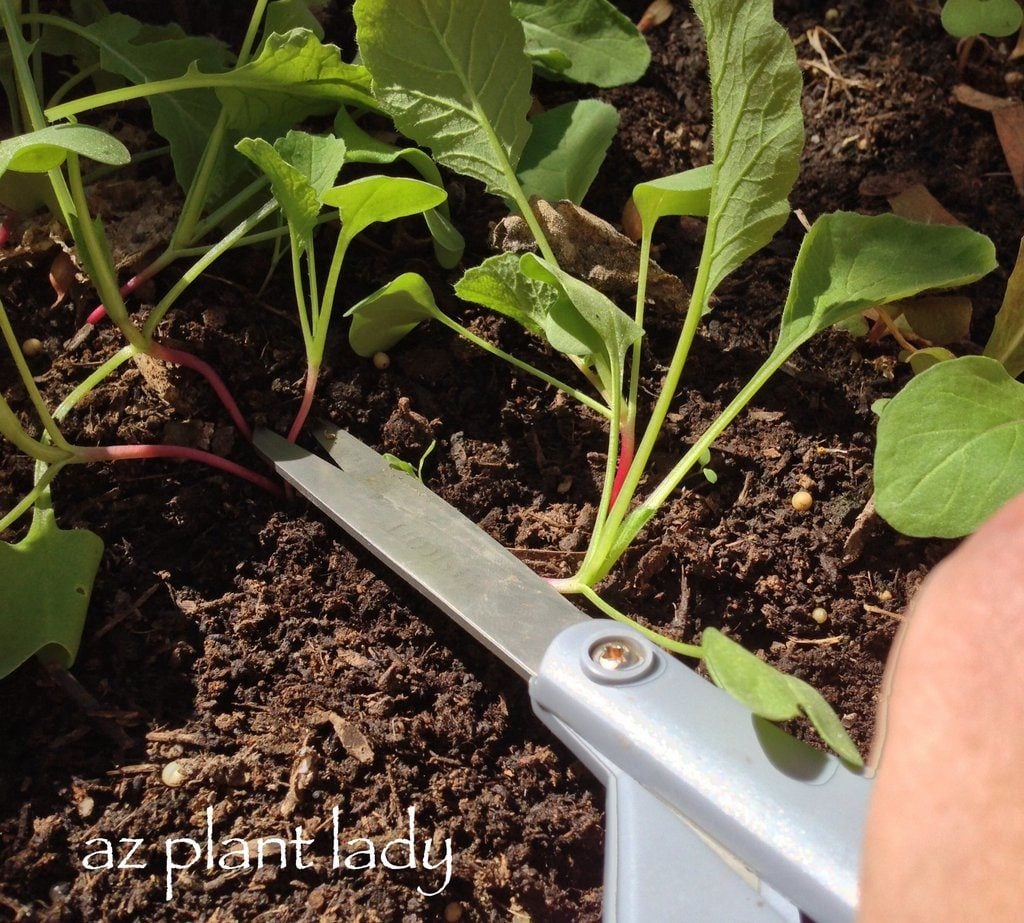
The roots will simply die once the top is removed.
Thinning vegetable seedlings is one of the simplest of gardening chores, but it is vital in order to grow healthy, full-sized vegetables. (You can also use this plant thinning method when growing flowers from seed.)
Treasured as much for their fragrance as their beautiful appearance, roses are beloved by many people around the world. If someone special in your life loves this special flower, these rose gifts will be sure to make their special day a happy one.
Petite Knockout Roses
Petite Knockout roses just might be the best rose gift. The low maintenance roses (plant them outdoors after last frost or in an indoor container) still pack a punch in beauty and scent. This mini version is easily transportable for the perfect rose surprise.
Want to send mom flowers? Here are the best flower and plant delivery services.
Personalized Wooden Rose
Personalize the name and rose color on this beautiful wooden rose, just in time for Valentine’s Day or Mother’s Day. It’s the perfect thing to dress up a bouquet of roses or mom’s place of honor at the brunch table.
Rose Gauntlet Gloves
Caring for roses properly takes a lot of time and effort, and a bit of a special talent. It can certainly be a thorny endeavor, though. Help your favorite gardener protect their hands and arms with a pair of rose gauntlet gloves. These have tough materials on the hands and then extend all the way up to arms to the elbows for complete coverage.
Check out the best tips for growing roses.
Rose Tea Towel
Bring a touch of the rose garden inside the kitchen with a well designed rose tea towel. The rose pattern is printed directly onto 100 percent cotton fabric, and is hemmed all the way around for quality that lasts.
Rose Quartz Butterfly Gua Sha Tool
Add a rose quartz butterfly to mom’s skin care routine with this gorgeous gua sha tool. Gua sha facial massage has been used for centuries in traditional Chinese medicine, and the treatment reduces puffiness, boosts collagen, and encourages lymphatic drainage. Pair it with a high quality rose-scented toner to really make her day (and skin) rose-filled.
Don’t miss these unique gifts for butterfly lovers.

Rose Stone Diffuser
Roses are a symbol of love, and this rose stone diffuser will remind mom just how much you love her every day. The ceramic rose-colored diffuser scents her home and doubles as a lovely piece of décor. Of course, add rose essential oils to complete the rose gift theme.
Don’t miss the best gifts for bee lovers.
Rose Quartz Heart Pendant
Rose quartz is a symbol of love, so this rose gift pendant is a gorgeous reminder of your feelings! The delicate chain and pretty pendant can be dressed up or down to accent any outfit.
Jo Malone Red Roses Cologne
Inspired by a beautiful blend of seven of the world’s most exquisite roses, Jo Malone Red Roses cologne is the perfect perfume for floral fans. It also features notes of crushed violet leaves and a hint of lemon. Heavenly!
Check out 18 fragrant roses to perfume your garden.
Keepsake Rose Heart-Shaped Wreath
Send roses with this rose heart-shaped wreath. Let the whole neighborhood know how much your gift recipient loves roses. So pretty!
Does mom love birds? Consider these cardinal gifts for redbird lovers.
Rose Petal Bath Bomb
Looking for an affordable rose gift? These rose petal bath bombs are big on quality and small on the bank account. Each is rose scented and decorated with rose petals. A luxury rose-scented bath? Priceless.
Check out the cutest bird bathroom décor items on Etsy.
Rose Recipe Cards
Know a cook who loves roses and sharing recipes? Combine their two hobbies with rose recipe cards. The set of 10 4- by 6-inch recipe cards features a gorgeous rose design, plus space for recipes.
Rose Jewelry Box
How pretty would a pair of rose-shaped jewelry box look on the bathroom vanity or dresser? Pro tip: fill the box with the rose quartz pendant from above!
Crabtree & Evelyn Rosewater Products
Take the sweet fragrance of roses wherever you go with the shower gels, hand creams, and lip balms from Crabtree & Evelyn’s rose collections. Rose essence has been used for centuries for better skin, and C&E distills their fragrance from the classic “hundred petal rose.”
Old-Fashioned DIY Rose Jars
Don’t have a lot to spend? You can make these easy DIY rose gifts yourself with just a few supplies. Buy roses at the grocery store to fill the jar with dried petals. Or, leave the jar empty to fill with the best roses of the garden all season long. Get the DIY here.
Check out these plant subscription boxes mom will love to receive!

What Foods Do Hummingbirds Eat?
If you want to attract these majestic fliers, you need to know what foods hummingbirds eat. Hummingbirds consume a variety of foods in their diet. They drink nectar from flowers and sugar water for energy. Roger Emerick of South Glastonbury, Connecticut, asks, “Should I add anything to the sugar water for my hummingbirds to make it more nutritious?”
When you’re feeding them at your hummingbird feeder, there’s no need to put in additives such as red dye or honey. Offer hummingbirds the perfect meal by making this sugar water recipe.
Learn how to attract hummingbirds with 10 expert tips.

Nectar-rich tubular flowers are another way for backyard birders to lure hummingbirds to eat in your backyard. Bee balm, salvia, coral honeysuckle and fuchsia are popular flowers with hummingbirds, offering the vibrant colors they love and easy access to nectar. However, the sweet stuff covers just one dietary need. Hummingbirds forage for other food sources besides flowers and feeders.
Check out jaw-dropping facts about hummingbirds. Plus, do you know how much hummingbirds weigh?

Do Hummingbirds Eat Mosquitoes?
Hummingbirds also require protein to survive. They get their fill of it by eating small insects like fruit flies, mosquitoes and gnats. They eat spiders, too. Multiple food sources like sugar water, flowers and bugs are especially important as baby hummingbirds seek nutrition and prepare for fall migration.
Hummingbirds are so resourceful that they often forage for insects in the sap wells drilled in trees by sapsuckers.
Like many other hummingbirds, Anna’s eat insects like midges and leaf hoppers. The high-protein diet might help them tolerate colder conditions in gardens, parks and streamside areas all along the West Coast year-round. Allen’s hummingbirds pluck bugs and spiders off spiderwebs.
How Often Do Hummingbirds Eat?

Because they constantly burn energy while on the move, hummingbirds may eat up to three times their body weight in a day. To find that much nectar, one bird might visit hundreds of flowers per day. This is why a hummingbird-friendly backyard is so important.
Anusha Shankar, a postdoctoral fellow conducting research at the Cornell Lab of Ornithology, explains why these birds are always eating. She says, “Hummingbirds need to eat constantly because they use up energy very quickly. If we had their metabolic rate, we’d need to eat 300 hamburgers a day to survive!”
Hummingbird fans will delight in these hummingbird-themed home decor items.
How Much Do Hummingbirds Eat?

“I use about a gallon of sugar water a day. Is it possible to determine how many hummingbirds I feed by the amount of sugar water they drink in a day?” asks Marge Kaufman of Sigel, Illinois.
According to lab studies, the amount of sugar water consumed by a hummingbird will vary depending on the richness of the sugar concentration. With the typical 4:1 ratio of water to sugar, a ruby-throat probably won’t drink more than about 2 fluid ounces per day. A gallon of sugar water could feed about 60 hummingbirds in a day! The actual number of individuals could be even higher if some are just stopping briefly, or it could be lower if some of the sugar water is being lost to evaporation, dripping, insects, etc. It’s tricky to come up with solid numbers, but it’s still fun to ponder how many hummers might be out there.
Birds & Blooms reader Elijah Gildea of Redding, California, writes, “Every spring and throughout most of the year, 50 to 100 hummingbirds visit my 11 feeders. They drink about 2 gallons of sugar water per day! April is my favorite month. I’ve had as many as six species show up then—Anna’s, rufous, Calliope, black chinned, Allen’s and a single Costa’s.”












